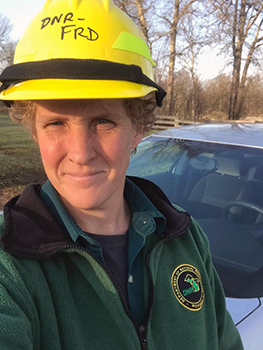
It never occurred to me as a child that there were perceptions about what women could not or should not do as a career.
Reality set in during college. When I attended Michigan Technological University in the late 1980s to obtain a Bachelor of Science degree in forestry, there were five women and around 35 men in the program my freshman year.
Unfortunately, diversity has not expanded much in the past 30 years of my career, and the percentage of women and minorities in forestry is still sadly low. As of 2019, women represented just 16% of forestry and conservation professionals in the United States, according to the Society of American Foresters.
There are a few advantages to this. Rarely is there a meeting or training event with my colleagues where I have to wait in line to use the ladies’ room, because it is common for there to be only two or three women in a room of 50 men.
When people find out I’m a forester, I often get asked if I’m a “ranger.” In most of North America, a ranger is the person we meet at our parks and campgrounds who helps care for the facilities and assures we all enjoy our time spent at them.
Since I’m not a ranger, the next question is, “what is a forester?”
We care for and manage the forests and trees of all kinds to suit the desired outcomes of a landowner. We are urban foresters, consulting foresters, state government foresters and more. We all have a deep love for the trees and the forested landscape.
Traditional foresters manage tracts of land with specific goals. Sometimes, that is to provide a haven for wildlife. Other times, it’s for timber production to create an income stream. On still other occasions, it’s to help the forest be as healthy as possible. Often, it’s a mixture of all those things, depending on who owns the land.
Just like other professions, there are various branches (pun intended) of forestry now.
When my career began, if you studied forest management, you were a forester. Foresters can now study ecology, ecosystems, environment, hydrology, engineering and many more specific courses of study.
As my career developed, my professional focus shifted to the raw material side of the forest industry. Before I joined the Michigan Department of Natural Resources Forest Resources Division team in 2015, I worked with loggers, sawmills and veneer mills for many years.
Working as a woman in forestry has difficult days. Even now, I am mistaken for a secretary more often than I would like. Sometimes, I’m instructed to “have the guy” (my colleague) call to talk about the issue at hand.
Walking into a meeting with a hard hat after 30 years in my profession, I get too much enjoyment watching the faces of sawmill owners and loggers as I discuss industry specifics with them, such as lumber thickness, logging site complications and trucking issues.
Their surprise at my expertise turns to curiosity and then to acceptance as they enjoy discussing the finer points of the forest industry with me.
Diversity is slowly widening, and integration is getting easier, due in part to the efforts of groups, such as the Women’s Forest Congress and Women Owning Woodlands, both formed during the last several years.
Women Owning Woodlands is a collaborative project of the National Woodland Owners Association and the U.S. Department of Agriculture Forest Service’s Cooperative Forestry Office. It supports women who own forested property across the United States.
The Women’s Forest Congress describes itself as a “new, dynamic, and inclusive forum to develop strategies, solutions and radical change for forests,” and I am proud to have been selected as a working delegate for the inaugural gathering Oct. 17-20 this year.
The ownership of the forests in North American is shifting to include more women all the time. They are searching for women foresters to connect with and learn from as they own and manage their own forestland. Space is expanding and the need for women foresters is growing every year.
We all have those days that make us shake our heads and question our career paths, but when you work in forestry, it’s easier to enjoy those days because you’re spending some time in the deep, cool green of a northern hardwood forest – and you get paid to do it.
We hear a great deal lately about forest bathing and how good it is for us to spend time outside, immersed in any part of nature. Just 15 minutes a day at your local park spent sitting under a tree or looking at a pond or listening intently for native birdsong provides long-term mental and physical health benefits.
It does not matter what your gender, ethnicity or race is. A career in natural resources can be the most rewarding path chosen because, as John Muir once wrote, “into the forest I go, to lose my mind and find my soul.”
A day in the forest can quiet the mental noise in our brains and enrich our souls with all that surrounds us.
How can you become a forester?
Michigan has two accredited forestry programs, at Michigan State University and Michigan Technological University. Details:
|